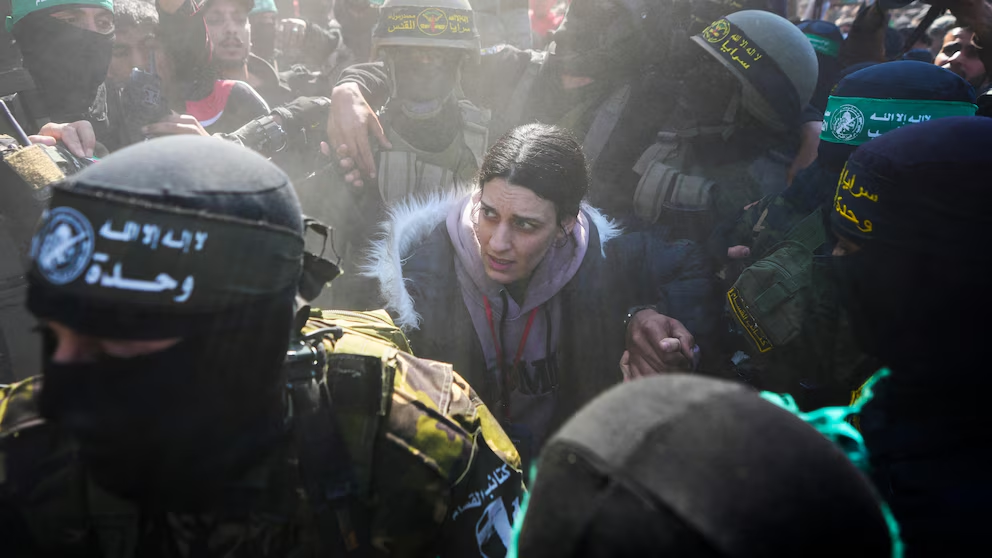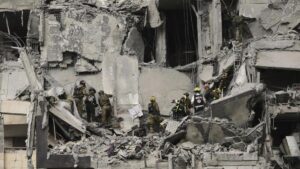Three Israeli Hostages and Dozens of Palestinian Prisoners Freed

The release of hostages and prisoners between Israel and Hamas has brought about a complex range of emotions for those involved. Three Israeli hostages—Yarden Bibas, 34, Ofer Kalderon, 53, and Keith Siegel, 65—were freed on Saturday after being held in Gaza by Hamas. Their release was part of a ceasefire deal struck in late December 2024, which also saw 183 Palestinian prisoners freed from Israeli detention. The hostages were handed over to the Red Cross in a ceremony that was carefully orchestrated, with armed Hamas fighters maintaining order and a banner behind them showcasing images of Hamas leaders who had been killed in the ongoing conflict.
The scene was notably different from Thursday’s chaotic release, when crowds surged forward in a disorganized attempt to get close to the hostages, raising concerns for their safety. The delay of Palestinian prisoner releases that day highlighted the risks of such intense crowds. However, the atmosphere on Saturday was more controlled. Still, the presentation, with armed militants flanking the hostages, sent a clear message: Hamas continues to project its authority in Gaza. The exchange of hostages took place in public, with the families of the freed prisoners—both Palestinian and Israeli—reacting with joy, though some also expressed concerns about the physical and emotional toll the ordeal had taken on the individuals involved.
The families’ reactions were poignant and varied. Keith Siegel, a U.S.-Israeli dual national, was welcomed back with cheers in Israel. His wife, Aviva, expressed her overwhelming happiness at his return. Yet, there were mixed emotions as well. His niece, Tal Wax, noted how relieved the family was to have him home but also pointed out how physically and emotionally drained he appeared. He had lost a significant amount of weight and his health was clearly affected by the long months of captivity.
For Ofer Kalderon, who had been held for 484 days, his family’s joy was tempered by the traumatic nature of his captivity. His relatives spoke of the immense emotional and physical toll he had endured, and his statement about looking forward to reuniting with his children highlighted the personal cost of the ordeal. Similarly, the release of Yarden Bibas stirred complex feelings. His wife and young children were also taken hostage during the Hamas attack on October 7, 2023, and though Hamas had claimed they were killed in an Israeli airstrike, they were later included in the list of hostages to be released. The uncertain fate of his family—whether they were killed or still in captivity—added an extra layer of heartbreak to his return. His story exemplifies the anguish faced by many families, as they hold on to hope for loved ones who are still missing.
In contrast, the release of Palestinian prisoners in the West Bank was celebrated by large crowds. Some of the prisoners, like Nasrallah Muammar, who had been imprisoned for 17 years, expressed a mixture of joy and sorrow, acknowledging the hardship of their time in prison while savoring the moment of freedom. Many of these prisoners had been held under “administrative detention,” a controversial practice where individuals can be imprisoned without charge or trial. While some of the released prisoners had been convicted of serious crimes, others were seen as political detainees by their supporters. The celebrations in Ramallah reflected the ongoing struggle and desire for freedom among Palestinians.
The broader context of these releases is also significant. Since the ceasefire agreement between Israel and Hamas began on January 19, 2025, there have been other positive steps, such as the reopening of the Rafah crossing between Gaza and Egypt, which had been closed for months. This allowed for the passage of medical patients from Gaza to Egypt, offering a glimmer of hope for those needing urgent care. However, the situation in Gaza remains dire, with reports from those returning to their homes describing devastation and destruction following months of Israeli airstrikes. The destruction in northern Gaza was so severe that many families were forced to return to the south, unable to return to their homes in the north.
As Israel and Hamas continue this fragile ceasefire and hostage exchange, the emotional impact on both sides is immense. The reunions, though hopeful, come with mixed emotions, as many families continue to grieve the losses they’ve endured. The broader geopolitical and humanitarian issues remain unresolved, with the ongoing tension and suffering serving as a reminder that these exchanges, while symbolic, are just one small step in a much larger and more painful conflict.







